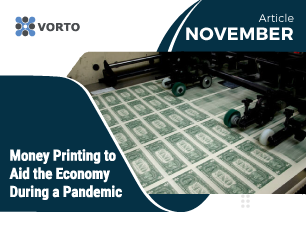Bobby Ward, Co-Founder of Vorto Trading proposes the question ‘with the money printing taking place around the world in response to the covid19 pandemic, could we see society going back to a gold standard to regain confidence in fiat currency?
By definition, the gold standard is a monetary system whereby a country’s currency and paper money has a value that is directly linked to gold. Within this gold standard system, countries agree to convert paper currency into a fixed amount of gold. Countries that use the gold standard will establish a fixed price for gold and then sell and buy at that price. With this system, countries determine the value of the currency with the fixed price.
Fiat money on the other hand is a government-issued currency that is not backed by a physical commodity like gold or silver. Instead, it is backed by the government that issued it and its value is found from the relationship between supply and demand, alongside the stability of the issuing government. Most modern currencies are fiat currencies, including the Euro and the U.S dollar.
Throughout our history, paper money has traditionally acted as promises to pay a trader of a specific amount of meals, typically gold or silver. We can see examples of fiat money with the assignats issued during the French Revolution or the greenbacks of the American Civil War period, or even as recent as the paper marks issued in Germany in the early 1920s. All of these examples mark deviations from the gold standard in preference of fiat money. At present, the gold standard is currently not used by any government. The United Kingdom ceased using the gold standing in 1931, the U.S followed suit in 1933 and abandoned remnants of the system in 1973.
However, it’s year is 2020 and we are amidst a second wave of covid19 and even greater economic uncertainty in markets. At time of writing and in response to this uncertainty, stocks have been falling since October 12 (WBAP) and we are heading towards a major deficit crisis. Agora Financial reports that the official budget deficit in the US totalled is $3.1 trillion, which is double the previous amount of $1.4 trillion recorded in 2009. This, alongside redundancies and company layoffs shows indications that we are heading towards a New Great Depression.
Further to this opinion, American lawyer and author of many books including Currency Wars: The Making of the Next Global Crisis; Jim Rickards revisits the history of gold and it has never looked better. Until now, the price of gold has been officially set. The decision on the number of dollars that could be exchanged for an ounce of gold was taken from this. However, once it was subject to free trade within the free market, we truly began to understand its value. Between the years 1971-1980, we experienced the first bull market whereby gold increased by 2200%. We experienced a second bull market between the years of 1999 and 2011 and gold increased by 760%. Since December 2015, gold’s value increased by 65%. In relation to the other two percentages, Jim Rickards argues that this is symbolic and the prices of gold could sky-rocket due to the fact we are now in a third bull market. If we look back at the last two bull markets and use this as a benchmark to predict gold’s value, the average price of gold would be $14,000 by 2025. What’s more, the increase of gold’s value could also be driven by the pandemic and a loss of confidence in the dollar. As part of the strategy to counter the economic impacts of the pandemic and boost the economy, the central bank is printing money. However, printing new money in the long term devalues it and can do more harm than good when fighting against recession.
With the value of gold potentially increasing, and the value of fiat currency decreasing during a global pandemic we are left with the question, should countries return to the gold standard in order to protect its economic health?
Speak to us for currency hedging solutions to help mitigate your risk in an unpredictable market. Email [email protected] or call us on +44 (0) 20 3307 1155 for further information.
